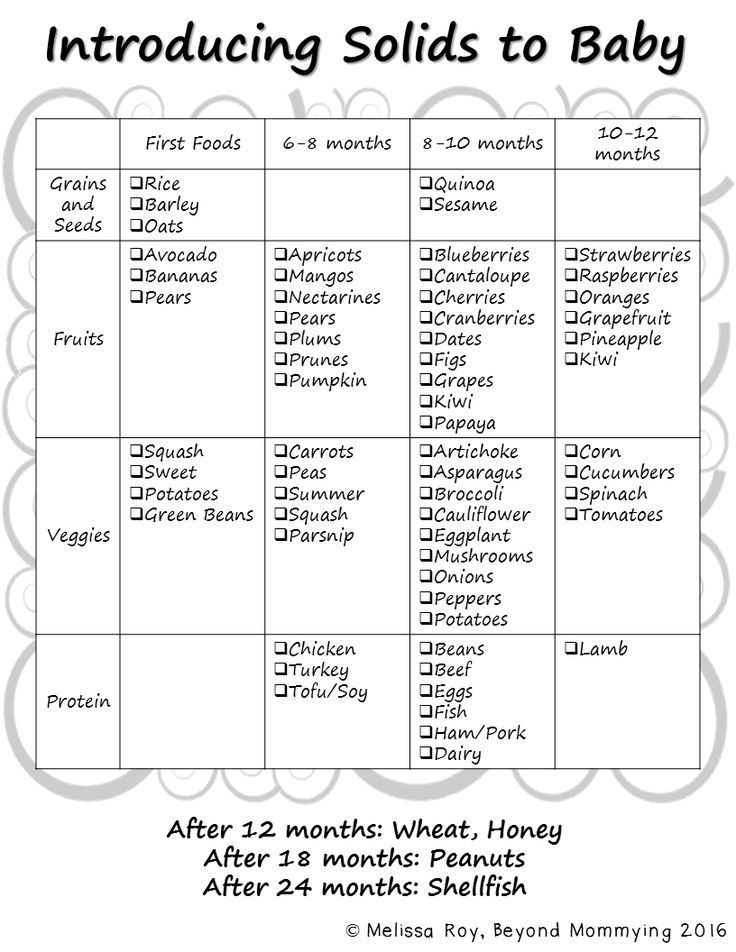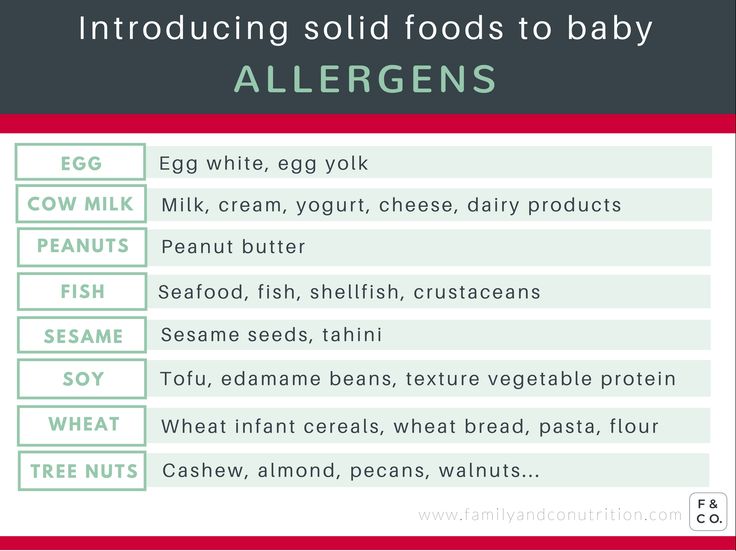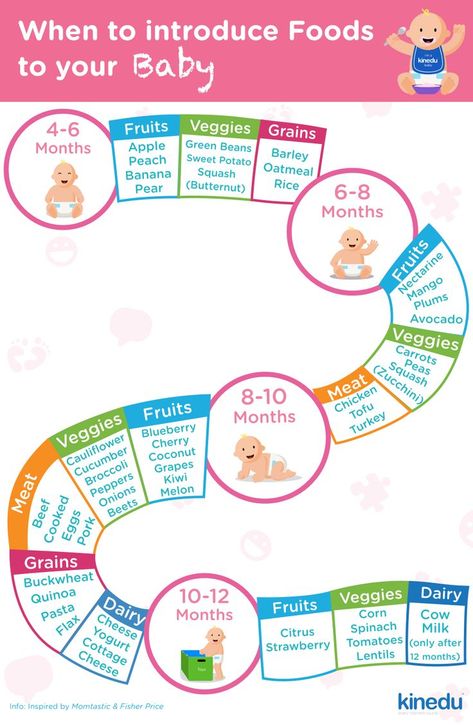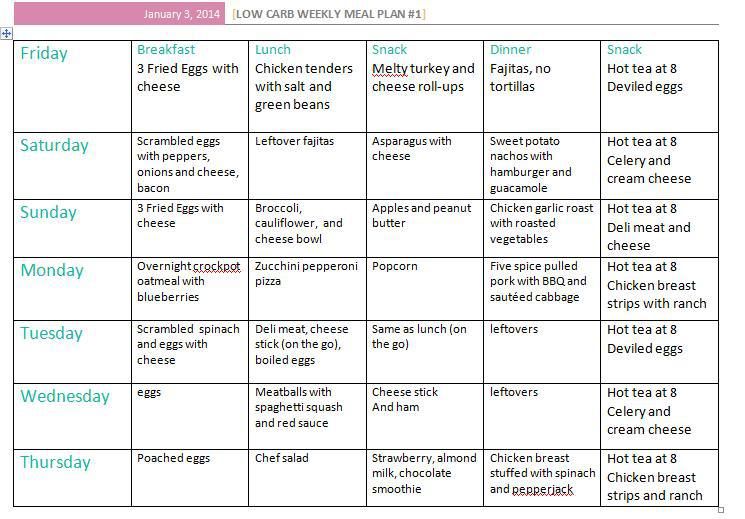Introducing food to your baby
When, What, and How to Introduce Solid Foods | Nutrition
For more information about how to know if your baby is ready to starting eating foods, what first foods to offer, and what to expect, watch these videos from 1,000 Days.
The Dietary Guidelines for Americans and the American Academy of Pediatrics recommend children be introduced to foods other than breast milk or infant formula when they are about 6 months old. Introducing foods before 4 months old is not recommended. Every child is different. How do you know if your child is ready for foods other than breast milk or infant formula? You can look for these signs that your child is developmentally ready.
Your child:
- Sits up alone or with support.
- Is able to control head and neck.
- Opens the mouth when food is offered.
- Swallows food rather than pushes it back out onto the chin.
- Brings objects to the mouth.
- Tries to grasp small objects, such as toys or food.
- Transfers food from the front to the back of the tongue to swallow.
What Foods Should I Introduce to My Child First?
The American Academy of Pediatrics says that for most children, you do not need to give foods in a certain order. Your child can begin eating solid foods at about 6 months old. By the time he or she is 7 or 8 months old, your child can eat a variety of foods from different food groups. These foods include infant cereals, meat or other proteins, fruits, vegetables, grains, yogurts and cheeses, and more.
If your child is eating infant cereals, it is important to offer a variety of fortifiedalert icon infant cereals such as oat, barley, and multi-grain instead of only rice cereal. Only providing infant rice cereal is not recommended by the Food and Drug Administration because there is a risk for children to be exposed to arsenic. Visit the U.S. Food & Drug Administrationexternal icon to learn more.
How Should I Introduce My Child to Foods?
Your child needs certain vitamins and minerals to grow healthy and strong.
Now that your child is starting to eat food, be sure to choose foods that give your child all the vitamins and minerals they need.
Click here to learn more about some of these vitamins & minerals.
Let your child try one single-ingredient food at a time at first. This helps you see if your child has any problems with that food, such as food allergies. Wait 3 to 5 days between each new food. Before you know it, your child will be on his or her way to eating and enjoying lots of new foods.
Introduce potentially allergenic foods when other foods are introduced.
Potentially allergenic foods include cow’s milk products, eggs, fish, shellfish, tree nuts, peanuts, wheat, soy, and sesame. Drinking cow’s milk or fortified soy beverages is not recommended until your child is older than 12 months, but other cow’s milk products, such as yogurt, can be introduced before 12 months. If your child has severe eczema and/or egg allergy, talk with your child’s doctor or nurse about when and how to safely introduce foods with peanuts.
How Should I Prepare Food for My Child to Eat?
At first, it’s easier for your child to eat foods that are mashed, pureed, or strained and very smooth in texture. It can take time for your child to adjust to new food textures. Your child might cough, gag, or spit up. As your baby’s oral skills develop, thicker and lumpier foods can be introduced.
Some foods are potential choking hazards, so it is important to feed your child foods that are the right texture for his or her development. To help prevent choking, prepare foods that can be easily dissolved with saliva and do not require chewing. Feed small portions and encourage your baby to eat slowly. Always watch your child while he or she is eating.
Here are some tips for preparing foods:
- Mix cereals and mashed cooked grains with breast milk, formula, or water to make it smooth and easy for your baby to swallow.
- Mash or puree vegetables, fruits and other foods until they are smooth.

- Hard fruits and vegetables, like apples and carrots, usually need to be cooked so they can be easily mashed or pureed.
- Cook food until it is soft enough to easily mash with a fork.
- Remove all fat, skin, and bones from poultry, meat, and fish, before cooking.
- Remove seeds and hard pits from fruit, and then cut the fruit into small pieces.
- Cut soft food into small pieces or thin slices.
- Cut cylindrical foods like hot dogs, sausage and string cheese into short thin strips instead of round pieces that could get stuck in the airway.
- Cut small spherical foods like grapes, cherries, berries and tomatoes into small pieces.
- Cook and finely grind or mash whole-grain kernels of wheat, barley, rice, and other grains.
Learn more about potential choking hazards and how to prevent your child from choking.
Top of Page
Helpful Resources | Nutrition | CDC
If you would like more information on topics related to feeding your baby or toddler, here are some resources:
General
CDC’s Infant and Toddler Nutrition microsite syndication
CDC offers a free Web Content Syndication service that gives public health partners the opportunity to syndicate CDC content directly to their sites without having to monitor or copy updates. To search the CDC infant and toddler nutrition website available for syndication as well as other resources you can share, visit the CDC Public Health Media Library and browse or search for “infant and toddler nutrition”. Learn more about content syndication and how to add CDC syndicated content on your site.
To search the CDC infant and toddler nutrition website available for syndication as well as other resources you can share, visit the CDC Public Health Media Library and browse or search for “infant and toddler nutrition”. Learn more about content syndication and how to add CDC syndicated content on your site.
CDC’s Child and Teen Resources
This collection of resources provides parents and caregivers, health care providers, and partners with tools and information to help children and teens maintain a healthy weight and prevent obesity.
CDC’s Child Development Positive Parenting Tips (Infants)
This CDC website provides information about infants’ development, as well as tips for positive parenting and promoting the safety and health of infants.
CDC’s Learn the Signs. Act Early.
This website includes tools to track children’s milestones and resources about children’s development.
CDC’s Parent Information
This CDC website provides resources and information on pregnancy, infants and toddlers, children, and teens. Learn how to handle common parenting challenges through interactive activities, videos, and more. Healthcare professionals and researchers can also find information on children’s health and safety.
Learn how to handle common parenting challenges through interactive activities, videos, and more. Healthcare professionals and researchers can also find information on children’s health and safety.
CDC’s Division of Oral Health
Tooth decay (cavities) is one of the most common chronic diseases of childhood in the United States. Untreated tooth decay can cause pain and infections that may lead to problems with eating, speaking, playing, and learning. CDC’s Division of Oral Health provides information on what parents and caregivers can do to ensure good oral health for your child.
Dietary Guidelines for Americans 2020–2025 pdf icon[PDF-30.6MB]external icon
These guidelines provide science-based advice for Americans on what to eat and drink to promote health, reduce chronic disease, and meet nutrient needs. The 2020–2025 edition provides recommendations for all life stages, including infants and toddlers.
Feeding Guidelines for Infants and Young Toddlers: A Responsive Parenting Approachexternal icon
This report presents recommendations for promoting healthy nutrition and feeding patterns for infants and toddlers from birth to 24 months, with an emphasis on dietary quality, portion sizes, and mealtime environment.
Healthy Childrenexternal icon
This website was developed by the American Academy of Pediatrics for parents. It features thousands of articles in English and Spanish on children’s health and safety, as well as interactive tools.
United States Department of Agriculture Special Supplemental Nutrition Program for Women, Infants, and Children (WIC)external icon
The WIC Program provides support to low-income pregnant, postpartum, and breastfeeding women, babies, and children up to age 5. WIC provides nutritious foods, information on healthy eating, breastfeeding promotion and support, and referrals to health care.
United States Department of Agriculture Supplemental Nutrition Assistance Program (SNAP)external icon
SNAP provides benefits to low-income individuals and families and provides economic benefits to communities.
Feeding and Beverage Recommendationsexternal icon
Healthy Eating Research, a national program of the Robert Wood Johnson Foundation, offers science-based recommendations for parents and caregivers. Tips are available for feeding children from birth through 24 monthsexternal icon and beverages for children from birth through 5 yearsexternal icon. Tips for older children are also available.
Tips are available for feeding children from birth through 24 monthsexternal icon and beverages for children from birth through 5 yearsexternal icon. Tips for older children are also available.
U.S. Food and Drug Administration (FDA) and Environmental Protection Agency’s (EPA) Advice About Eating Fishexternal icon
The U.S. FDA and EPA provide advice regarding eating fish. This advice can help people make informed choices when it comes to the types of fish that are nutritious and safe to eat. It is especially important for those who might become pregnant, who are pregnant, or who are breastfeeding, as well as for parents and caregivers who are feeding children. This advice supports the recommendations of the Dietary Guidelines for Americans.
Top of Page
Breastfeeding
CDC’s Breastfeeding Information
CDC’s Division of Nutrition, Physical Activity, and Obesity (DNPAO) is committed to increasing breastfeeding rates throughout the United States. CDC provides information for public health professionals and others to help support breastfeeding mothers, such as managing breastfeeding during various maternal and infant illnesses and conditions, any precautions for vaccines during breastfeeding, and recommendations for proper storage and handling of expressed human milk.
CDC provides information for public health professionals and others to help support breastfeeding mothers, such as managing breastfeeding during various maternal and infant illnesses and conditions, any precautions for vaccines during breastfeeding, and recommendations for proper storage and handling of expressed human milk.
International Lactation Consultant Association (ILCA)external icon
ILCA is the member association for professionals who care for breastfeeding families. ILCA’s “Find a Lactation Consultant Directory” can help you find a lactation consultant to get the breastfeeding support you need.
United States Lactation Consultant Association (USLCA)external icon
USLCA is a professional association for International Board Certified Lactation Consultants (IBCLCs) and other health care professionals who care for breastfeeding families. USLCA’s “Find an IBCLC” can help you find a lactation consultant to get the breastfeeding support you need.
WIC, the Special Supplemental Nutrition Program for Women, Infants, and Children—Breastfeeding Support external icon
The United States Department of Agriculture Special Supplemental Nutrition Program for Women, Infants, and Children (WIC) Breastfeeding Support website includes resources for expectant and current mothers about breastfeeding, overcoming common challenges, and thriving to make breastfeeding work for their families.
La Leche League USAexternal icon
La Leche League USA helps mothers to breastfeed through mother-to-mother support, encouragement, information, and education and promotes a better understanding of breastfeeding as an important element in the healthy development of the baby and mother.
Office on Women’s Healthexternal icon
The Office on Women’s Health’s vision is for all women and girls to achieve the best possible health outcomes. They provide information on breastfeeding to help women make infant feeding decisions and to guide mothers through the breastfeeding process.
Top of Page
Infant Formula
Questions & Answers for Consumers Concerning Infant Formulaexternal icon
The U.S. Food & Drug Administration regulates infant formula and has a list of questions and answers about infant formula.
Infant Formula Do’s and Don’tsexternal icon
The U.S. Food and Drug Administration provides information on infant formula preparation and storage, as well as other tips on how to keep infant formula safe.
Top of Page
Food Safety
Food Safety Concerns for Children Under Fiveexternal icon
Food safety is particularly important for young children. Foodsafety.gov provides information on safely preparing food for your child.
Top of Page
Meal Time
Fruits & Veggies—Have a Plant Movementexternal icon
A resource designed to help spread the word about the health benefits of adding more fruits and veggies to your diet.
USDA MyPlate Kitchenexternal icon
This online tool features a large collection of recipes and resources to support building healthy and budget-friendly meals. Site features include:
- Extensive search filters on cuisine, cooking equipment, nutrition content, and more.
- Detailed nutrition information.
- Cookbooks to browse and download or build your own.
- Recipe star ratings, review comments, and sharing on social networks.
Video Series on How to Introduce Solid Foods
1,000 Days has developed helpful videos about introducing solid foods to your baby. Topics include:
Topics include:
- Is your baby ready to start eating foods?
- What is a good first food for your baby?
- What to expect when introducing first foods
- How much should I feed my baby?
- How to win at mealtimeexternal icon
- What foods should my baby avoid?
- What should your baby eat in the first year?
Top of Page
Vitamins and Minerals
Vitamin and Mineral Fact Sheetsexternal icon
The National Institutes of Health’s Office of Dietary Supplements has fact sheets for consumers and health professionals about vitamins, minerals, and dietary supplements.
Top of Page
How to introduce a child to adult food
Komsomolskaya Pravda
Dom. FamilyMom and babyMom and baby: Health
April 7, 2015 16:30
We talk about the rules for introducing the first complementary foods
How to introduce a child to adult food - we will tell in our article!Photo: GLOBAL LOOK PRESS
Digestion in the first months after birth crumbs can only cope with mother's milk (or infant formula). For the rest of the food, the body is not yet “ripe”.
For the rest of the food, the body is not yet “ripe”.
Pediatricians recommend introducing your baby to adult food at about 4-6 months of age. Of course, the pediatrician will tell you more exactly the right time to start complementary foods, because the developmental features of your child are important here - his digestion, metabolism, and the functioning of the central nervous system.
As pediatrician Nadezhda Maruseva explained to us , by 5-6 months the gastroenterological tract of a small person becomes more mature, the mucous membrane of the small intestine is no longer so permeable, immunity is “stronger”, important digestive enzymes that can break down and digest "complex" food. And a child under 4 months is simply not able to swallow even semi-liquid food, not to mention pieces of food.
How do you know when the perfect moment has come?
It is dangerous to introduce a new food to a child too soon. The baby may not be able to cope with digestion, and everything will end with a pain in the tummy. And early complementary foods increase the risk of developing food allergies.
And early complementary foods increase the risk of developing food allergies.
But it is not worth delaying the introduction of complementary foods, because if you miss the moment, the baby may start to act up and refuse new products. At about 6 months, the basic skills are formed: bite, chew, swallow thick and solid food, and untimely introduction of complementary foods can affect the further development of the child as a whole.
And by the age of 6 months, the child's digestive system not only "ripens", but also the energy consumption increases, the baby becomes more active (turns over, sits down, crawls) and light mother's milk no longer replenishes energy costs. It is by the general development of the child that the mother (and pediatrician) can assess whether the baby is ready to try mashed potatoes.
The first one went...
For the first time, offer the baby half a spoonful of puree or porridge. If you didn’t like the puree right away, don’t give up, offer again the next day. If a child spits out food, it does not always mean that he does not like the taste. Perhaps this is still the “push” reflex that babies have from birth (it is needed so that the baby can only swallow milk and not choke). So be patient.
If a child spits out food, it does not always mean that he does not like the taste. Perhaps this is still the “push” reflex that babies have from birth (it is needed so that the baby can only swallow milk and not choke). So be patient.
What's in the first spoon?
Puree or porridge - pediatrician will advise. For example, children who are underweight are usually given a hearty porridge first, and vegetables are usually given to robust ones.
“The sequence of introducing complementary foods and the choice of products depends on the state of health of the child,” says FrutoNyanya expert P.V. Shumilov, Doctor of Medical Sciences, Professor, Head. Department of Hospital Pediatrics, Russian National Research Medical University named after N.I. Pirogov . – “Children with reduced body weight as the first main complementary food are prescribed cereals of industrial production, enriched with iron, calcium, zinc, iodine, and vegetable puree for overweight children. ”
”
Important rules for feeding
- Don't worry or get angry if the porridge hits the wall and the whole table is smeared with puree. Your baby will immediately feel the negativity and will also worry. And you need to turn eating into pleasure!
- The first dish must consist of one component (mashed potatoes from one vegetable, porridge from one cereal). To understand whether the child will not give an allergic reaction to a new dish, offer one product a little at a time, look at the reaction, and only after 5-7 days add the second product. This way you can track down what triggers the allergy.
- Introduce new food FROM THE SPOON first, then supplement with breast or formula. Otherwise, a well-fed baby will not be interested in even the newest dish.
- Try a new dish in the morning to track the reaction until the evening.
Age category of the site 18+
The online publication (website) is registered by Roskomnadzor, certificate El No. FS77-80505 dated March 15, 2021.
FS77-80505 dated March 15, 2021.
I.O. EDITOR-IN-CHIEF OF THE SITE - KANSKY VICTOR FYODOROVICH.
THE AUTHOR OF THE MODERN VERSION OF THE PUBLICATION IS SUNGORKIN VLADIMIR NIKOLAEVICH.
Messages and comments from site readers are posted without preliminary editing. The editors reserve the right to remove them from the site or edit them if the specified messages and comments are an abuse of freedom mass media or violation of other requirements of the law.
JSC Publishing House Komsomolskaya Pravda. TIN: 7714037217 PSRN: 1027739295781 127015, Moscow, Novodmitrovskaya d. 2B, Tel. +7 (495) 777-02-82.
Exclusive rights to materials posted on the website www.kp.ru, in accordance with the legislation of the Russian Federation for the Protection of the Results of Intellectual Activity belong to JSC Publishing House Komsomolskaya Pravda, and do not be used by others in any way form without the written permission of the copyright holder.
Acquisition of copyright and communication with the editors: [email protected]
Introducing food to the baby - how to develop food interest?
The topic of the correct selection and time for the baby to get acquainted with the first products is perhaps considered the most relevant among mothers. Most pediatricians recommend introducing complementary foods between 4 and 6 months, it is at this age that the child is actively growing, he needs more vitamins and minerals. Your baby's gastrointestinal tract is ready to accept new foods, so you can try giving "adult" foods in small doses.
Be sure to ask your pediatrician or family doctor for advice on how to properly introduce complementary foods and which foods are right for your baby. If a child is not gaining weight well, it is often recommended to start complementary foods with cereals, and plump people with excellent weight are the first to try vegetable purees.
It is important to know the basic rules for the introduction of complementary foods:
- During teething, the child may be reluctant to eat food, there is a sharp deterioration in appetite;
- Do not introduce complementary foods too late to prevent vitamin and mineral deficiencies;
- Fruits or juices are introduced last - after sweet tastes, the child will lose interest in unleavened vegetables;
- A new product is introduced 3-4 weeks after the introduction of the first;
- Up to a year, milk or an adapted mixture remains a priority - complementary foods introduce the baby to food;
- New products are not introduced during the period of illness, in too hot weather, and also 2 days before and a few days after vaccination.

The main signs of a child’s readiness for complementary foods are that the baby is actively interested in the contents of the plate, he already has teeth. The second factor is rather controversial, because in some children the first teeth erupt only by 8-9months, so you need to navigate by the child. If he is interested in what mom and dad eat, feel free to try, of course, only healthy food. If you are interested in what food interest is, it is quite simple: when a baby is actively interested in what parents, grandparents eat, tries to grab and eat a piece of bread, an apple.
Basic nuances and principles of the introduction of complementary foods
It is necessary to give food before feeding with formula or breast milk, always from a spoon, and not from a nipple. Weaning purees should be slightly thicker than milk or formula. An important rule: start complementary foods with one-component purees, after the introduction of two or three products, they can be mixed.
A new product is introduced from the amount of half a teaspoon, and in a week it is brought to a volume corresponding to the age norm. Introducing complementary foods one at a time is important to identify allergic reactions (flushing, eating disorders).
How to enter porridge correctly? If the child is prone to constipation, it is better not to choose rice, give preference to corn or buckwheat, which do not contain gluten. You need to start with one component, gradually mix different cereals, creating new tastes. The first porridges are boiled in water, without the addition of salt and sugar.
When the child has tried porridge, you can introduce fruits. First they give a harmless apple and pear, since they rarely cause allergies, then you can give peach, plum and apricot to try. Fruits are given in a baked form, without added sugar.
There are two principles for the introduction of complementary foods - pediatric and pedagogical. The first is the most common, and its essence is to give the child food strictly according to the scheme indicated above.
Pedagogical complementary foods have the main goal to introduce the child to food, to form the correct eating behavior. There are no clear schemes and methods. Most parents combine both of these approaches to develop the right feeding strategy for their baby.
Baby food - do-it-yourself or canned?
This question also worries mothers very much, how to properly feed the baby - canned food or cook it yourself? In this matter, everything is quite individual, each mother decides how it is more convenient for her and the baby. Canned purees save time, and you can be sure they're made to standard, safe ingredients.
If you do not want to spend a lot of time cleaning, preparing a dish for the first feeding, it is better to buy canned purees in the first months. Of course, provided that your baby likes such food - some fussy people only want to eat food prepared by mom. As the diet expands and the portion size increases, you can cook cereals, mashed potatoes, meat pies on your own.
Child refuses complementary foods
Often, mothers also face such a phenomenon when the baby does not want to eat - neither mashed potatoes, nor pieces, nor a spoon, nor from a hand. Of course, this behavior first plunges the mother into a panic, because the child needs to be fed at any cost! It is important to remain calm and not nervous, because the baby subtly feels the mood of the mother.
Not all children begin to eat exactly from 6 months, for some, food interest wakes up only at 8 or even 9 months. Calmly offer your baby different tastes, let's try food from your plate (provided that you eat right). Offer different dishes - your baby may not like cereal, but he loves to eat vegetables and potatoes. Every child is different and only you can find the right approach.
If the question "The child does not eat complementary foods, what should I do?" is extremely relevant for you, you may be interested in complementary foods BLW (baby-led weaning).











